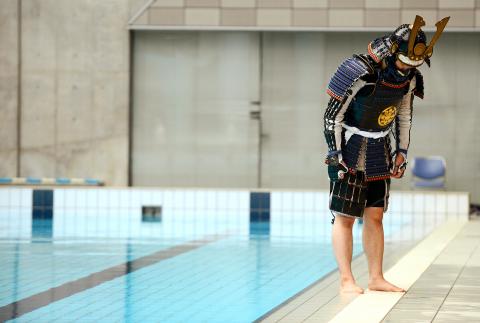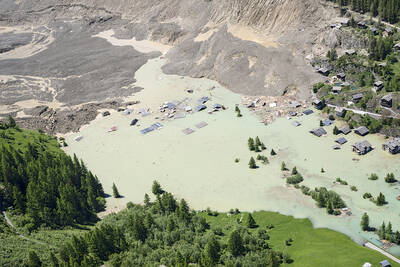Walking or running in a full suit of samurai armor is not the easiest thing in the world. Swimming in it is even harder, but that’s exactly what some in Japan are doing. For fun.
“It’s heavy, and it’s hot in here ... Fan me hard,” Mutsuo Koga, a 27-year-old doctor, told fellow disciples of traditional Japanese swimming at a recent meet.
“I’m worried about whether I’ll be able to get myself back out of the water. It’s been three years since I last swam,” Koga said as he readied to take the plunge in a public swimming pool.

Photo: AFP
Traditional swimming was developed during Japan’s feudal 15th and 16th centuries, when feared samurai swordsmen roamed the country enforcing their masters’ will.
Part survival technique — there were times when a warrior just had to swim for it, boots and all — and part aesthetic performance, traditional swimming now has its place in the pantheon of Japanese martial arts.
And like all martial arts, its adherents say it has real-life applications.
“The primary purpose of this kind of swimming is to acquire practical skills for swimming in a real environment,” said Tadao Koga, Mutsuo’s father and the grand master of the Kobori school, one of 12 recognized by the Japan Swimming Federation.
“If you can swim fast using Western strokes, that doesn’t mean you can survive in a natural environment,” said Koga, 67.
Traditional swimmers have to master a kind of treading water, which will allow them to withstand powerful waves near a seashore.
They also have to learn the hayanuki stroke, vital for swimming against a current or up a river, thrusting your body high into the air as your arms crash into the foam.
Whatever happens, you have to keep your head above the water and your wits about you — that obstacle looming in front of you could be a rock, or it could be an axe-wielding enemy.
Oh, and you have to do it while wearing 15kg of armor.
The appeal of the sport is that “swimmers compete on form and beauty, rather than the speed of swimming,” said Yoko Suzuki, 25, a champion of women’s traditional swimming.
Masahiko Yaginuma, chairman of the Japanese Traditional Swimming Committee of the swimming federation, said the form was widely taught in schools in the early 20th century, but fell out of favor and is now only found in a few institutions.
“Nowadays women in their 60s or older are the main group of new learners,” because they see traditional swimming as an extension of the other noble arts a cultured Japanese woman learns — like flower arranging and tea ceremony, he said.
Briton Antony Cundy, a Tokyo-based advertising executive who has spent years being tutored in the Kobori school of swimming, said there were real benefits to taking up the sport.
“It’s a fun way of getting fit and enjoying Japanese culture and history,” Cundy said. “It’s astonishing you don’t see many foreigners enjoying it.”
Around a minute after he slid heavily into the water, Mutsuo Koga slowly and unsteadily hauled himself out to roaring applause from the assembled crowd.
He had managed about 20m using a stroke designed to make him glide across the surface of the water, his helmeted head making no abrupt moves.
“Your chest was supposed to be above the water,” Tadao chastised, as his son stood panting on the poolside.
“I was not very good,” Mutsuo gasped. “My body didn’t float at all.”

The collapse of the Swiss Birch glacier serves as a chilling warning of the escalating dangers faced by communities worldwide living under the shadow of fragile ice, particularly in Asia, experts said. Footage of the collapse on Wednesday showed a huge cloud of ice and rubble hurtling down the mountainside into the hamlet of Blatten. Swiss Development Cooperation disaster risk reduction adviser Ali Neumann said that while the role of climate change in the case of Blatten “still needs to be investigated,” the wider impacts were clear on the cryosphere — the part of the world covered by frozen water. “Climate change and

Poland is set to hold a presidential runoff election today between two candidates offering starkly different visions for the country’s future. The winner would succeed Polish President Andrzej Duda, a conservative who is finishing his second and final term. The outcome would determine whether Poland embraces a nationalist populist trajectory or pivots more fully toward liberal, pro-European policies. An exit poll by Ipsos would be released when polls close today at 9pm local time, with a margin of error of plus or minus 2 percentage points. Final results are expected tomorrow. Whoever wins can be expected to either help or hinder the

Packed crowds in India celebrating their cricket team’s victory ended in a deadly stampede on Wednesday, with 11 mainly young fans crushed to death, the local state’s chief minister said. Joyous cricket fans had come out to celebrate and welcome home their heroes, Royal Challengers Bengaluru, after they beat Punjab Kings in a roller-coaster Indian Premier League (IPL) cricket final on Tuesday night. However, the euphoria of the vast crowds in the southern tech city of Bengaluru ended in disaster, with Indian Prime Minister Narendra calling it “absolutely heartrending.” Karnataka Chief Minister Siddaramaiah said most of the deceased are young, with 11 dead

DENIAL: Musk said that the ‘New York Times was lying their ass off,’ after it reported he used so much drugs that he developed bladder problems Elon Musk on Saturday denied a report that he used ketamine and other drugs extensively last year on the US presidential campaign trail. The New York Times on Friday reported that the billionaire adviser to US President Donald Trump used so much ketamine, a powerful anesthetic, that he developed bladder problems. The newspaper said the world’s richest person also took ecstasy and mushrooms, and traveled with a pill box last year, adding that it was not known whether Musk also took drugs while heading the so-called US Department of Government Efficiency (DOGE) after Trump took power in January. In a